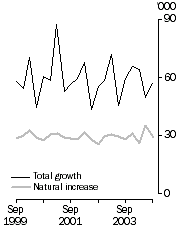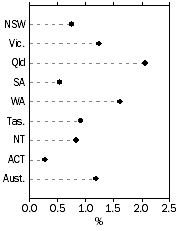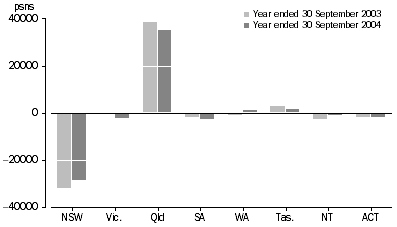SEPTEMBER KEY FIGURES
 | Population at end Sep qtr 2004 | Change over previous year | Change over previous year |  |
| PRELIMINARY DATA | '000 | '000 | % |  |
|  |
| New South Wales | 6,744.4 | 50.1 | 0.7 |  |
| Victoria | 4,988.8 | 61.3 | 1.2 |  |
| Queensland | 3,899.6 | 78.6 | 2.1 |  |
| South Australia | 1,536.3 | 8.2 | 0.5 |  |
| Western Australia | 1,989.6 | 31.6 | 1.6 |  |
| Tasmania | 483.0 | 4.4 | 0.9 |  |
| Northern Territory(a) | 200.4 | 1.7 | 0.8 |  |
| Australian Capital Territory | 324.0 | 0.9 | 0.3 |  |
| Australia(b) | 20,168.9 | 236.7 | 1.2 |  |
|  |
| (a) September quarter 2004 birth registrations for the Northern Territory appear to lower than expected. This may indicate an irregular lag in birth registrations. Birth registrations for December quarter 2004 will be assessed when available. |
| (b) Includes Other Territories comprising Jervis Bay Territory, Christmas Island and the Cocos (Keeling) Islands. |
Population growth

| Population growth rate, Year ended current quarter

|
SEPTEMBER KEY POINTS
ESTIMATED RESIDENT POPULATION
- The preliminary estimated resident population (ERP) of Australia at September 2004 was 20,168,900 persons, an increase of 236,700 persons since September 2003 and 57,600 persons since June 2004.
- Preliminary natural increase during the September quarter 2004 was 29,100 persons.
- Preliminary net overseas migration during the September quarter was 28,400, a decrease of 10% on the September quarter 2003.
POPULATION GROWTH RATES
- The Australian population grew 0.3% during the September quarter 2004 and 1.2% during the 12 months ended September 2004.
- During the September quarter 2004 all states and the Northern Territory experienced positive population growth, while the Australian Capital Territory remained relatively unchanged.
FEATURE ARTICLES
- At 30 June 2003, an estimated 23% of the Australian population were born overseas. Those born in the United Kingdom were the largest overseas born group (1.1 million), followed by those born in New Zealand (428,000), Italy (231,600), Viet Nam (174,600) and China (173,100).
- In 2003 there were 106,400 marriages registered and 53,100 divorces granted in Australia. This represents an increase of 960 marriages (1%) and a decrease of 860 divorces (2%) on numbers recorded in 2002.
NOTES
INTRODUCTION
Estimated resident population (ERP) data in this publication are based on the 2001 Census of Population and Housing. Exceptions are tables 17, 18 and 19 (excluding 2001 estimates), which are based on the 1996 Census of Population and Housing.
CHANGES IN THIS ISSUE
The layout and content of this publication has changed. The major changes are detailed below.
- A feature article, Population by Country of Birth has been included in this issue. This article includes previously unpublished data for 30 June 2003 on ERP by country of birth.
- A feature article, Marriages and Divorces, Australia 2003 has been included in this issue.
Revisions included in this issue are as follows:
- Population estimates for Capital City Statistical Divisions and selected Statistical Districts are now based on the 2004 Australian Standard Geographical Classification (cat. no. 1216.0).
- The propensities for changes in travel behaviour in Table 2 of the Technical Note - Measuring Net Overseas Migration have been revised and applied to the September quarter 2004. The impact of this revision on earlier quarters is being evaluated.
ERP DATA STATUS
At any point in time this publication contains final, revised and preliminary ERP data. The status of the ERP data included in this issue is as follows:
- Final - All ERP data up to and including June quarter 2001
- Revised - ERP data from September quarter 2001 to June quarter 2003, inclusive
- Preliminary - ERP data from September quarter 2003 to September quarter 2004, inclusive.
NORTHERN TERRITORY BIRTHS
September quarter 2004 birth registrations for the Northern Territory appear to be lower than expected. This may indicate an irregular lag in birth registrations. Birth registrations for December quarter 2004 will be assessed when available.
DATA NOT YET AVAILABLE
Household estimates for 2002 and 2003 are currently under review.
INQUIRIES
For further information about these and related statistics, contact the National Information and Referral Service on 1300 135 070 or Rachael Hill on Canberra (02) 6252 6296.
MAIN FEATURES
INTRODUCTION
The preliminary estimated resident population (ERP) of Australia at September 2004 was 20,168,900 persons, an increase of 236,700 (1.2%) since September 2003 and 57,600 (0.3%) since June 2004. During the September quarter 2004 the male population increased to over 10 million (10,024,300). The female population reached this milestone 12 months previously in the September quarter 2003.
COMPONENTS OF AUSTRALIA'S POPULATION CHANGE
The growth of Australia's population has two components: natural increase (the number of births minus the number of deaths) and net overseas migration (net permanent and long-term movement plus the migration adjustment).
Natural increase
Natural increase during the September quarter 2004 was 29,100 persons, contributing 51% to Australia's quarterly population growth. The number of births registered during the September quarter 2004 was 66,000, while the number of deaths registered was 36,900.
Natural increase for the year ended September 2004 was 122,100, representing an increase of 4% (or 4,300 persons) on the number recorded in the year ended September 2003. Births contributed 255,100 babies and deaths removed 133,000 persons from the population.
September quarter 2004 birth registrations for the Northern Territory appear to be lower than expected. This may indicate an irregular lag in birth registrations. Birth registrations for December quarter 2004 will be assessed when available.
Net overseas migration
During the September quarter 2004 net overseas migration (28,400 persons) contributed 49% to Australia's quarterly population growth. This was a decrease of 10% (or 3,100 persons) on the number recorded in September quarter 2003. During the September quarter 2004 there were 111,600 permanent and long-term arrivals and 83,200 permanent and long-term departures after migration adjustments.
The Australian Bureau of Statistics (ABS) applies a number of adjustments to the overseas arrivals and departures data used to produce estimates of net overseas migration (NOM). These mainly comprise adjustments designed to reflect differences between stated travel intentions and actual travel behaviour, but (in the case of revised NOM estimates) also include adjustments to transform numbers of overseas movements into numbers of travellers. These are collectively referred to as 'migration adjustments'. For more information see the Technical Note - Measuring Net Overseas Migration.
STATES AND TERRITORIES
Population
The population of Australia's states and territories at September 2004 were as follows: New South Wales 6,744,400, Victoria 4,988,800, Queensland 3,899,600, South Australia 1,536,300, Western Australia 1,989,600, Tasmania 483,000, Northern Territory 200,400, and the Australian Capital Territory 324,000.
During the September quarter 2004 the Northern Territory's population passed 200,000 persons.
Consistent with the amendments to the Commonwealth Electoral Act 1918, estimates of the population of each of the Other and External Territories are listed separately in table 7 of this publication. The populations of the Other Territories continue to be included in the Australian totals presented in other tables (see paragraph 2 of the Explanatory Notes).
Growth rates
Except for the Australian Capital Territory, all states and the Northern Territory recorded positive population growth during the September quarter 2004. Queensland recorded the highest growth (0.5%), followed by Western Australia (0.4%), Victoria and the Northern Territory (each 0.3%), New South Wales and Tasmania (each 0.2%), and South Australia (0.1%). The Australian Capital Territory remained relatively unchanged.
For the year ended September 2004 all states and territories recorded a positive growth rate. The highest growth was recorded by Queensland (2.1%), followed by Western Australia (1.6%) and Victoria (1.2%). The lowest growth rate was recorded by the Australian Capital Territory (0.3%).
Interstate migration
During the September 2004 quarter Queensland, Western Australia and Tasmania recorded net interstate migration gains, and the remaining states and territories recorded net losses. Interstate migration was the largest contributor (43%) to Queensland's quarterly population growth with a gain of 7,600 persons. Western Australia gained 290 persons and Tasmania gained 140 persons. New South Wales lost the largest number of persons through interstate migration (-6,000) followed by the Australian Capital Territory (-830), South Australia (-530), Victoria (-520) and the Northern Territory (-150).
A similar pattern is also reflected in the net interstate migration for the year ended September 2004, with net gains recorded for Queensland (35,100), Tasmania (1,800) and Western Australia (1,300) and losses recorded for New South Wales (-28,800), South Australia (-3,100), Victoria (-2,500), the Australian Capital Territory (-2,300) and the Northern Territory (-1,500).
NET INTERSTATE MIGRATION, States and territories

 Print Page
Print Page
 Print All
Print All